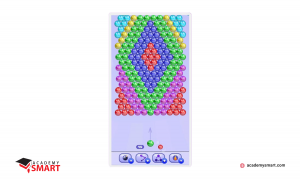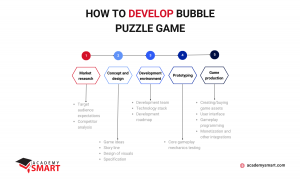How to develop a bubble shooter game
Casual bubble games are a popular genre of small-weight video games with a long history of success and demand. Their accessibility, universal appeal, and short play sessions suit a broad audience. With a diverse range of game types and a stress-relieving nature, bubble games offer something for everyone and remain a go-to choice for quick, enjoyable entertainment. These are just some reasons why creating your own casual game app is a good idea. Moreover, monetizing such applications today is completely easy. So, this article will tell you what bubble games are and how to develop bubble shooters quickly and profitably.
History of bubble games
The history of bubble games, also known as bubble shooters or marble-popping games, traces its roots from the 1970s to the present day. A bubble has become a popular base for video games, particularly in the puzzle and casual gaming genres, because of its simplicity and convenience in programming and replicating the form on the screen. Game creators have built several engaging gameplays accessible and approved by the broadest audience using this elementary and elegant shape. Here’s a brief overview of the key milestones in the history of bubble games.
The concept of bubble games can be outlined back to early arcade games like “Taito’s Space Invaders” (1978) and “Atari’s Missile Command” (1980), which involved shooting objects from the player’s base. The genre gained significant recognition with the release of “Puzzle Bobble” (also known as “Bust-A-Move” in North America) in 1994 by Taito. This iconic arcade game featured a bubble shooter mechanic with a puzzle twist, where players aimed to match and pop bubbles to clear levels.
The early 2000s saw the rise of casual gaming platforms, such as Flash games on the web and mobile games. It led to the proliferation of bubble games on various devices. In 2003, PopCap Games released “Zuma,” which added a new dimension to the genre. It combined the bubble-shooting mechanic with a winding path and introduced bonuses, becoming a huge success.
The introduction of smartphones and app stores in the mid-2000s opened up a new era for bubble games. Titles like “Bubble Shooter” and “Bubble Mania” became popular among multiple mobile gaming apps. The 2010s met a diversification of the bubble game genre, with various subgenres emerging. Games like “Angry Birds POP!” added physics-based elements to bubble shooting.
Today’s bubble games thrive on various platforms, from mobile apps to social media and PC gaming. They usually incorporate cross-platform play abilities, innovative power-ups, and popular social features. Casual games like puzzle bubbles are often built not only by specialized game dev teams but also by full-stack developers of mobile and web applications, such as Academy Smart. It is not surprising since broader experience in creating various online apps allows us to confidently solve multiple specific challenges, examples of which you may see in the promo video below.
Types of bubble games
As you may understand from the title, the main operating elements of bubble games are bubbles of different colors or sizes, with which certain events occur. The specifics of interaction with bubbles determine the game’s play mechanics and sub-genre features. Of course, it is impossible to strictly classify bubble games based on game mechanics since they often combine several game principles.
However, it is still possible to identify some typical features and then, based on them, divide bubble games into the types of bubble shooters, marble-popping, and bubble puzzles. Based on the duration of the game round, they can be divided into limited and endless. Concerning the possible storyline, they can be arbitrary or included in it, introducing elements of the RPG adventure genre.
We can also talk about differences in the platform for bubble games. In this case, they can be divided into standalone on-premise, web-based and mobile apps. Modern games are often designed to be cross-platform.
Mobile bubble game examples
Over its fifty-year history, many wonderful bubble gaming apps have appeared with various game mechanics. Here’s a list of some of the most well-known ones from multiple subgenres of bubble games:
- Bubble Shooter – The classic and widely recognized bubble shooter game.
- Bubble Witch Saga – A popular series of bubble shooter games with a magical theme.
- Bubble Bobble – A classic arcade game that features bubble-blowing dragons.
- Zuma – The original and iconic marble-popping game.
- Luxor – A series of marble shooter games with an Egyptian theme.
- Sparkle – A marble shooter game with puzzle and match-3 elements.
- Puzzle Bobble (Bust-A-Move) – A classic arcade game that combines bubble shooting with match-3 gameplay.
- Bubble Island – A mobile game that blends bubble shooting and match-3 mechanics.
- Bubble Mania – A match-3 bubble game with various power-ups and challenges.
- Peggle – A puzzle game where players aim and shoot balls to clear pegs, incorporating physics and strategy.
- Angry Birds POP! – A bubble shooter with physics-based bubble popping featuring the famous Angry Birds characters.
- Goo Saga – A physics-based puzzle platformer with bubble elements.
- Lost Bubble – A puzzle adventure game where players explore different environments by solving bubble-related puzzles.
- Bubble Trouble – An arcade-style game where players shoot bubbles to defend against bouncing balls.
- Bubble Tanks – A series of games where players use bubble shields to defend against enemy bubbles.
- Bubble Blaze – A fast-paced endless bubble game with various challenges and power-ups.
- Bubblez! – A multiplayer bubble shooter game with competitive and cooperative modes.

A popular bubble shooter game that our team worked on
What is a bubble shooter game
A bubble shooter game is a one-screen puzzle video game where players aim and shoot colored bubbles to match and eliminate them from the game board. The primary objective is usually to clear the entire board of bubbles. These games are known for their simple yet addictive gameplay and have been popular on various platforms, including mobile devices and web browsers.
Bubble shooter games are accessible and suitable for beginners. The core principle involves shooting bubbles from a cannon or launcher and matching them to form groups of three or more bubbles of the same color. When groups of bubbles are matched, they burst, clearing space on the game board and earning points.
On touchscreen devices, players aim by dragging their fingers, while on the web-based version, the mouse is used for seeking. Releasing the touch or the mouse button launches the bubble. Bounce shots off the game window’s sides are also possible.
Matching more than three bubbles in a single shot leads to higher scores. Planning and strategizing, considering the color of the next bubble in the queue, is essential to succeed. The purpose is to clear the entire board by making as many matches as possible and progressing to the next level. The game provides ample time for players to complete each challenge. As the game advances, levels become more challenging, requiring players to employ bounce and trick shots to pop bubbles efficiently. Fewer moves result in higher scores.
Some particular elements typically enhance gameplay. Matching ten or more bubbles can charge a booster bomb to clear nearby bubbles. Bi-colored bubbles can be popped by hitting the ammo bubble to either color. Some games incorporate realistic physics, where the trajectory and interactions of bubbles are crucial to solving puzzles or challenges. Bubbles may also be affected by gravity, requiring players to account for gravity’s influence when aiming. Or, the entire bubble cluster can rotate, adding a dynamic element to the game experience.
Bonuses, such as daily rewards and in-game currency, improve enjoyment and engagement. Players can unlock new missions, prizes, and team-based features. Joining teams may provide additional gifts and competitive elements.
As a rule, bubble shooter games contain different modes, including:
- simplified gameplay of Classic Mode, where matching three same-colored bubbles remains the objective;
- a retro version of Arcade Mode with fewer power-ups, offering increasingly challenging levels.
Signs of successful bubble game
A successful bubble shooting game is not just about the lucky initial launch but also about maintaining player engagement, adapting to evolving player preferences, and offering a satisfying gaming experience over time. How to develop bubble shooter and be sure that it will resonate with fans of the genre? Make sure you consider all relevant components outlined below.
Engaging Gameplay
The game should offer simple yet exciting gameplay that keeps players returning for more. It should be easy to understand but challenging to master, striking the right balance between skill and luck. Perfect bubble games have intuitive touch or mouse controls for aiming and shooting bubbles. The controls should feel responsive and natural, ensuring a smooth gaming experience.
High-quality graphics, vibrant colors, and appealing bubble designs enhance player engagement. The game’s aesthetics should be pleasing and match the overall theme. Storylines can add depth and intrigue to the game, creating a more immersive and personalized experience. The game’s atmospheric and unobtrusive soundtrack is also essential for relaxing the mind and taking a break from the everyday hustle and bustle.
Gradual increase in difficulty
While the game may start easy, it should gradually introduce complexity. New players should have a smooth onboarding experience with clear tutorials or guidance on how to play. A well-designed learning curve ensures that new players can enjoy the game while providing challenges for experienced ones. The game may incorporate variations of the bubble shooting genre, such as unique power-ups, puzzles, gameplay twists, or themed events to keep players interested.
A well-structured level progression system keeps players motivated. As they advance, levels should become progressively more challenging, introducing new obstacles, patterns, or mechanics. Bonuses, boosters, or special bubbles can add depth and excitement to the gameplay. These elements have to provide players with tools to overcome tricky levels or achieve higher scores.
Incentives, rewards, and leaderboards
Thriving bubble games offer incentives and rewards for continued play. Daily encouragement, achievements, and unlockable content motivate players to return and complete objectives. An excellent practice is creating temporary events with unique feats and trophies that coincide with significant and memorable dates.
Integration of leaderboards and competitive elements allows players to compare their scores with others, fostering competition and social engagement. It is equally essential to ensure the comfortable implementation of social features like team play, friend challenges, or sharing achievements on social media, which can enhance player engagement and virality.
Technical excellence
A stable and well-performing game, with minimal bugs or crashes, contributes to a positive player experience. Ongoing support and updates, including new levels, features, and bug fixes, demonstrate the developer’s commitment to the game’s longevity.
Good bubble games are often available on multiple platforms to reach a wider audience, including mobile devices, web browsers, and social media platforms. As a rule, these applications include precise feedback mechanisms for players to report issues, provide suggestions, or contact support. So, it’s easy for bubble games to receive positive user reviews and high ratings on app stores or gaming platforms, reflecting player satisfaction.
Monetization strategy
A transparent and fair monetization strategy is crucial to make your game app profitable. While many bubble games offer free gameplay, in-app purchases or ads can generate good revenue. In casual games, the freemium model works well with additional paid content and bonuses that excite the play experience and allow users to get achievements faster and more efficiently. You have even more opportunities to earn income thanks to the variety of possible advertising options in the form of links, goods, or promotional videos intelligently integrated into the gameplay. Pay special attention to balancing the monetization models with player enjoyment, and the approval of your bubble shooter is guaranteed.

How to develop a bubble shooter profitably
Bubble shooter game development checklist
Of course, you’d like to know how to develop bubble game since you are still reading this article. What steps do you need to take?
Step 1. Market research
First, dive into the topic and start with market research. Get to know your target audience and its preferences, as well as your closest competitors and the features of their games. Analyze the competition to identify unique selling points, determining monetization strategies and pricing models used here. This way, you will understand the expectations of your future players, evaluate the pros and cons of competitors’ applications, and see opportunities to provide a unique gaming experience for users and ways to earn money for yourself.
Step 2. Concept and design of the game
Define the game concept and core gameplay mechanics. Create a game design document outlining rules, objectives, and features. Outline the basis of the storyline and its stylistic characteristics. Design the visual part, including characters, backgrounds, and bubble designs. As a result, you should have a detailed specification describing various aspects of the game, based on which a technical task will be formulated for designers, web and mobile developers, programmers, and QA engineers.
Step 3. Development environment
Choosing the right development environment for your bubble shooting game is pivotal. You should start by selecting a suitable game engine or finding a competent development team to advise appropriate solutions. Popular choices include Unity, Unreal Engine, Buildbox, and GameMaker Studio. Consider your development team’s expertise. If it has experience with a particular engine, it can expedite the development process.
Keep in mind the platforms your game will target, such as mobile devices, web browsers, or consoles, and ensure the chosen engine supports them. Think about the performance requirements of your bubble shooting game. Some engines may better meet your performance goals based on the complexity of gameplay and graphics. In addition, check the available assets, plugins, and community support for the chosen one. Cross-platform capabilities can help expand your game’s reach.
Examine the scalability of the chosen engine. It should handle potential updates, additional content, and the growth of your game. If you plan to monetize your game through ads or in-app purchases, ensure that your chosen development environment can accommodate these monetization methods.
Step 4. Prototyping
Develop a basic prototype to test the core gameplay mechanics, like the ability to shoot bubbles, match colors, and clear groups of bubbles. Note that prototypes typically use minimalist or placeholder graphics to represent game elements. The emphasis is on functionality and proving that the gameplay is engaging rather than visual aesthetics. Prototypes should be quick to create and test. This agility enables you to experiment with various gameplay elements and adjust as needed. Rapid prototyping helps identify flaws and potential improvements early in development.
During the prototyping phase, gather feedback from playtesters. This feedback can be invaluable in identifying issues with gameplay, controls, or other aspects of the game. Use this input to refine and enhance the prototype. Experiment with variations of bubble behavior, power-ups, and obstacles. Try different shooting mechanics and bubble physics to see what feels most enjoyable. Prototyping allows you to explore these options without committing to a final design.
Maintain documentation during the prototyping phase. Record your design decisions, changes made, and the results of playtesting. This documentation will be valuable as you transition from the prototype to complete development.
Step 5. Game production
To create a bubble shooter game, you may need to develop a unique graphical user interface and implement backend functionality for web-based and social games. It can involve considering game logic, web hosting, interaction with central servers for multiplayer or social features, API integrations, database management, and more. The specific requirements depend on the type and complexity of the game and its intended platform.
Prepare art and game assets, including high-quality graphics for backgrounds, bubbles, character designs, UI elements, menus, HUD (Heads-Up Display) components, background music, and sound effects. Ensure visual assets are optimized for various screen sizes and resolutions.
Of course, you may go traditional and hire artists, animators, and composers to create unique art content. However, a more pragmatic and faster way how to develop a bubble shooter is to buy the necessary art assets, music tracks, and other reusable elements, utilizing them with minor modifications. Fortunately, now the game development market allows quick access to suitable stock sources at a reasonable price, and this significantly simplifies, reduces the cost, and speeds up the creation of a software product.
Develop all the nuances of the user-friendly user interface according to the specifications:
- game screen, background animation, bubble models and behavior, puzzle structures and events associated with them, pop-ups of messages and bonuses, etc.;
storyline screen; - game settings menu;
- table of records,
- feedback form, and so on.
Translate in-game text and instructions into multiple languages if targeting a global audience, ensuring cultural sensitivity and appropriate localization.
Implement the core gameplay mechanics with a level progression system of increasing difficulty. Integrate audio elements into the game, with options to mute or adjust volume. Ensure player data security and comply with privacy regulations. Conduct thorough testing to identify and fix bugs, glitches, or gameplay issues and optimize performance for smooth gameplay on various devices.
Integrate analytics tools to collect data on player behavior and game performance and utilize it to make informed decisions for game improvements. Implement in-app purchases, ads, or other monetization methods you’ve chosen and balance them with player experience to avoid frustration.
As all checkpoints of the specification are ready and tests are completed, release your bubble shooter game and build your community.

How to develop bubble game: common customer’s guide
Academy Smart as bubble shooter mobile game developer
Even though the main activity of our IT company is the development of complex enterprise applications, Smart Academy programmers have solid experience in creating and customizing web and mobile applications for casual games. For the last five years, our developers, team leads, and QA testers, as outstaffing employees, have been creating cool and exciting casual games of various subgenres with hundreds of thousands of downloads on app stores for our partners. Many of our workers already have practical experience in the game dev industry for up to 8 years and are ready to share that expertise with you. You may see other software products delivered from our portfolio here.

Academy Smart’s projects
Our team is glad to offer you the services of strong Python, Java, and JavaScript programmers, full-stack web developers, mobile developers, experienced QA engineers, business analysts, and project managers to perform work on outstaffing or outsourcing the development of turnkey bubble game applications.
You will quickly and profitably create an exciting casual game with our assistance. Contact us and share your ideas.
A Bubble Shooter Game Development: Frequently Asked Questions
What is a bubble shooter game?
A bubble shooter game is a puzzle video game where players typically shoot colored bubbles from the bottom of the screen to match and eliminate groups of bubbles of the same color at the top.
How may you earn money from a casual bubble game application?
You can generate revenue through diverse monetization methods such as in-app advertisements, in-app purchases for power-ups or additional lives, offering premium versions with extra features, and integrating rewarded ads for in-game rewards or currency.


